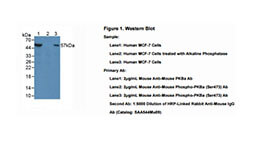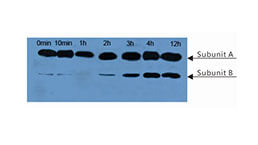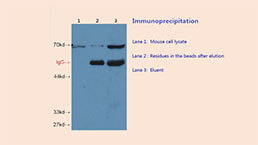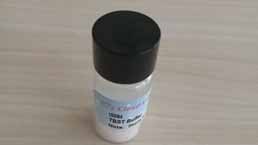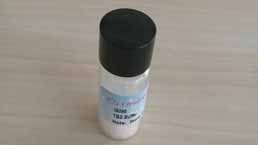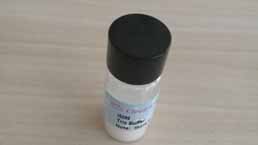Biotin-Linked Polyclonal Antibody to Amyloid Beta Peptide 1-42 (Ab1-42) 

Overview
Properties
- Product No.LAA946Ra71
- Organism SpeciesRattus norvegicus (Rat) Same name, Different species.
- ApplicationsWB; IHC; ICC.If the antibody is used in flow cytometry, please check FCM antibodies.
Research use only - Downloadn/a
- CategoryNeuro science
- SourceAntibody labeling
- Ig Type IgG, Potency n/a
- PurificationAntigen-specific affinity chromatography followed by Protein A affinity chromatography
- LabelBiotin
- Original Antibody n/a
- Buffer FormulationPBS, pH7.4, containing 0.02% NaN3, 50% glycerol.
- TraitsLiquid, Concentration 500µg/mL
Sign into your account
Share a new citation as an author
Upload your experimental result
Review

Contact us
Please fill in the blank.
Specifity
The antibody is a rabbit polyclonal antibody raised against Ab1-42. It has been selected for its ability to recognize Ab1-42 in immunohistochemical staining and western blotting.
Usage
Western blotting: 0.2-2µg/mL;1:250-2500
Immunohistochemistry: 5-20µg/mL;1:25-100
Immunocytochemistry: 5-20µg/mL;1:25-100
Optimal working dilutions must be determined by end user.
Storage
Store at 4°C for frequent use. Stored at -20°C in a manual defrost freezer for two year without detectable loss of activity. Avoid repeated freeze-thaw cycles.
Stability
The thermal stability is described by the loss rate. The loss rate was determined by accelerated thermal degradation test, that is, incubate the protein at 37°C for 48h, and no obvious degradation and precipitation were observed. The loss rate is less than 5% within the expiration date under appropriate storage condition.
Giveaways
Increment services
Citations
- Blockade of Tau Hyperphosphorylation and Aβ1–42 Generation by the Aminotetrahydrofuran Derivative ANAVEX2-73, a Mixed Muscarinic and σ1 Receptor Agonist, in a Nontransgenic Mouse Model of Alzheimer’s DiseasePubmed: 23493042
- The γ-secretase inhibitor 2-[(1R)-1-[(4-chlorophenyl)sulfonyl](2,5-difluorophenyl) amino]ethyl-5-fluorobenzenebutanoic acid (BMS-299897) alleviates Aβ1–42 seeding and short-term memory deficits in the Aβ25–35 mouse model of Alzheimer's diseasePubmed: 23123349
- 慢病毒介导的CBS基因过表达对原代皮质神经元Globesci:Source
- 外源性硫化氢对高糖条件下原代神经元β淀粉样蛋白的影响J-Smu:Source
- Effects of Aluminium on β-Amyloid (1–42) and Secretases (APP-Cleaving Enzymes) in Rat BrainPubmed:24792732
- Amyloid ? lowering and cognition enhancing effects of ghrelin receptor analog [D-Lys (3)] GHRP-6 in rat model of obesityPubmed:25296496
- Anesthetic Propofol Attenuates Apoptosis, Aβ Accumulation, and Inflammation Induced by Sevoflurane Through NF-κB Pathway in Human Neuroglioma CellsPubMed: 25809614
- Autophagy dysfunction upregulates beta-amyloid peptides via enhancing the activity of γ-secretase complexPubMed: 26316755
- Geniposide attenuates insulin-deficiency-induced acceleration of β-amyloidosis in an APP/PS2 transgenic model of Alzheimer's diseasePubMed: 25882166
- The Potential Effect of Epigallocatechin-3-Gallate alone or in Combination with Vitamin E and Selenium on Alzheimer's Disease Induced by Aluminum in Ratsopen-access:
- 芝麻素对高糖条件下PC12细胞Aβ和BACE-1表达的影响article:10299
- Tong Luo Jiu Nao, a Chinese Medicine Formula, Reduces Inflammatory Stress in a Mouse Model of Alzheimer's DiseasePubmed:26993489
- ОСОБЕННОСТИ ПРОЦЕССОВ ФОРМИРОВАНИЯ ПОКАЗАТЕЛЕЙ ФУНКЦИОНАЛЬНОГО СОСТОЯНИЯ ВЫСШЕЙ НЕРВНОЙ ДЕЯТЕЛЬНОСТИ И ХАРАКТЕРИСТИКИ ВНИМАНИЯ СТУДЕНТОВSMB-2016-03-062.pdf
- 芝麻素对高糖条件下PC12 细胞Aß 和BACE 1 表达的影响QK:92621A
- Geniposide attenuates the level of Aβ1–42 via enhancing leptin signaling in cellular and APP/PS1 transgenic micepubmed:28160136
- Effects of dietary glucocerebrosides from sea cucumber on the brain sphingolipid profiles of mouse models of Alzheimer's disease.pubmed:28232989
- Norovirus P particle-based active Aβ immunotherapy elicits sufficient immunogenicity and improves cognitive capacity in a mouse model of Alzheimer’s diseasearticles:srep41041.ris
- Cerebrosides from Sea Cucumber Protect Against Oxidative Stress in SAMP8 Mice and PC12 Cellspubmed:28406733
- Mechanisms of DHA-enriched phospholipids in improving cognitive deficits in aged SAMP8 mice with high-fat dietPubmed:29986309
- Effects of n-3 PUFA enriched and n-3 PUFA deficient diets in naïve and Aβ-treated female ratsPubmed:30028991
- Sub-chronic celecoxib prevents soluble beta amyloid-induced depressive-like behaviour in ratsPubmed:29879605
- Punicalagin ameliorates the elevation of plasma homocysteine, amyloid-β, TNF-α and apoptosis by advocating antioxidants and modulating apoptotic mediator proteins in brain modulating apoptotic mediator …Pubmed:29579708
- Effects of Astaxanthin and Docosahexaenoic-Acid-Acylated Astaxanthin on Alzheimer's Disease in APP/PS1 Double-Transgenic MicePubmed:29695154
- Amelioration by nitric oxide (NO) mimetics on neurobehavioral and biochemical changes in experimental model of Alzheimer's disease in ratsPubmed:29522778
- CART peptide activates the Nrf2/HO-1 antioxidant pathway and protects hippocampal neurons in a rat model of Alzheimer's diseasePubmed:29777699
- Deletion of plasma Phospholipid Transfer Protein (PLTP) increases microglial phagocytosis and reduces cerebral amyloid-β deposition in the J20 mouse …Pubmed:29731975
- Ellagic acid ameliorates learning and memory impairment in APP/PS1 transgenic mice via inhibition of β‑amyloid production and tau hyperphosphorylationDoi: 10.3892/etm.2018.6860
- 非编码RNA miR-137 调控tau 蛋白磷酸化和L 型钙离子通道CACNA1C 参与阿尔茨海默病的发生
- (台灣農業研究67 (4): 355-364) 香菇柄水萃物改善糖尿病降低阿茲海默氏症罹病風險初探
- The Efficacy of Sauropus androgynus Leaves Extract To Improve Cognitive Function in Wistar Rats Induced Alzheimer's
- Effect of Aluminum-Maltolate on the Content of Aβ Protein and the Expression of ApoER2, VLDLRs, and LRP1 in PC12-ApoE4 CellsPubmed: 30649678
- Imbalance of Microglial TLR4/TREM2 in LPS-Treated APP/PS1 Transgenic Mice: A Potential Link Between Alzheimer's Disease and Systemic InflammationPubmed: 30756214
- Repetitive transcranial magnetic stimulation protects mice against 6-OHDA-induced Parkinson's disease symptoms by regulating brain amyloid β level
- Obstructive sleep apnea may increase the risk of Alzheimer's diseasePubmed: 31487291
- Nanoformulated ellagic acid ameliorates pentylenetetrazol-induced experimental epileptic seizures by modulating oxidative stress, inflammatory cytokines and …Pubmed: 31728888
- Neurobiological determinants of depressive-like symptoms in rodents
- Mahanimbine-induced neuroprotection via cholinergic system and attenuated amyloidogenesis as well as neuroinflammation in lipopolysaccharides-induced …
- Dietary Malted Barley Grain Improved Structure and Function of Spinal Cord of Mother Rats fed on a high cholesterol diet.
- Ex Vivo Investigation of Bexarotene and Nicotinamide Function as a Protect?ve Agent on Rat Synaptosomes Treated with A¦Â (1-42)33428094
- Comparative study on the effects of phosphatidylserine rich in DHA and EPA on A¦Â-intervened Alzheimer's disease using cell models33876786
- Protective effects of repetitive transcranial magnetic stimulation against 6-OHDA-induced Parkinson's symptoms in a mice model: the key role of miR-409-3p/PDHB ¡34078216
- Immunization with A¦Â3-10-KLH vaccine improves cognitive function and ameliorates mitochondrial dysfunction and reduces Alzheimer's disease-like pathology in Tg ¡34044034
- The effect of a 6-month Ketogenic Medium-Chain Triglyceride Supplement on Plasma Cardiometabolic and Inflammatory Markers in Mild Cognitive?¡33906081
- Potential Therapeutic Effects of New Ruthenium (III) Complex with Quercetin: Characterization, Structure, Gene Regulation, and Antitumor and Anti-Inflammatory Studies (RuIII/Q Novel Complex Is a Potent Immunoprotective Agent)
- GPNMB mitigates Alzheimer's disease and enhances autophagy via suppressing the mTOR signal34695452
- The influence of vinpocetine alone or in combination with Epigallocatechin-3-gallate, Coenzyme COQ10, Vitamin E and Selenium as a potential neuroprotective …34706318
- Probiotics ameliorates LPS induced neuroinflammation injury on Aβ 1–42, APP, γ-β secretase and BDNF levels in maternal gut microbiota and fetal …Pubmed:35312928
- New Thienopyridine Scaffold as An Antidementia Lead: In Silico Study and Biological Screening







